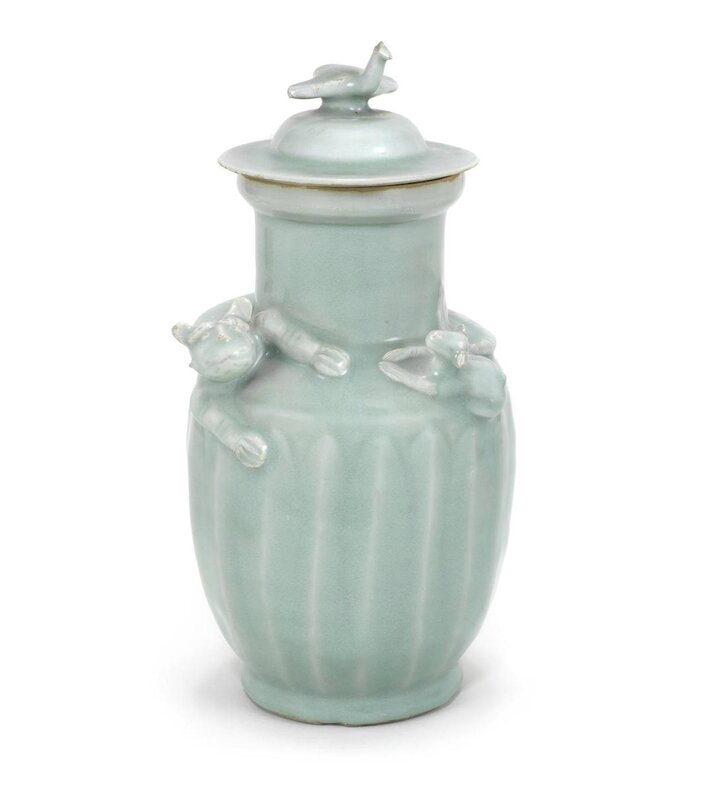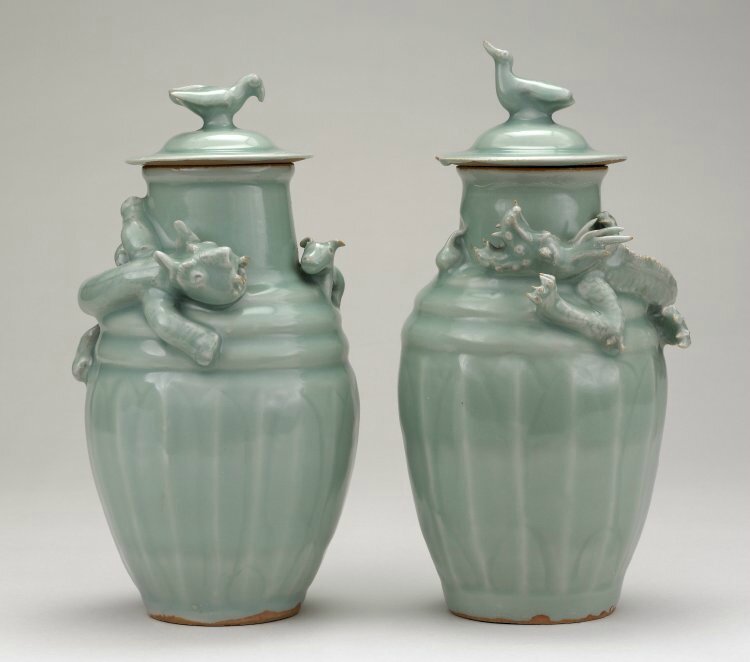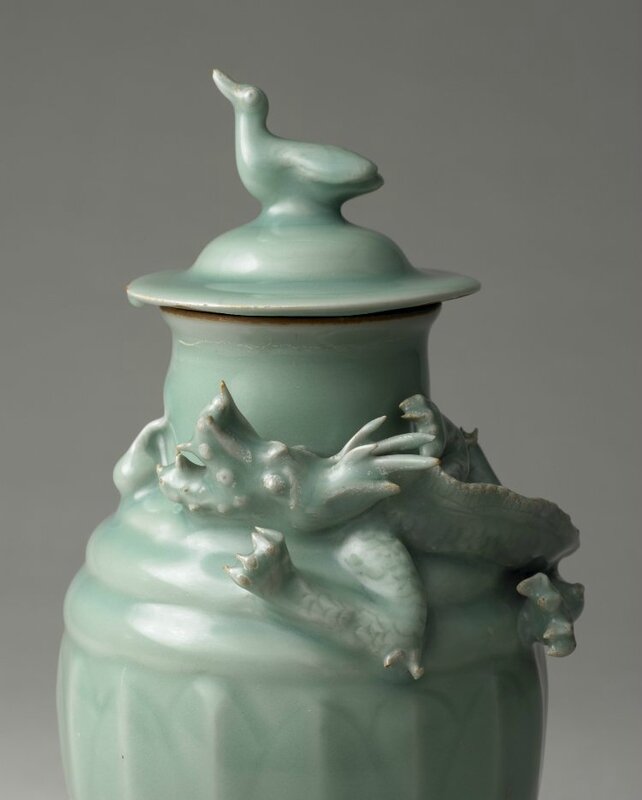A fine and rare Longquan celadon-glazed 'funerary' jar and cover, Southern Song Dynasty (1127–1279)
Lot 10. A fine and rare Longquan celadon-glazed 'funerary' jar and cover, Southern Song Dynasty (1127–1279); 26.4cm (10 3/8in) high. Estimate £15,000 - 20,000 (€17,000 - 22,000). Sold for £ 47,500 (€ 53,145). Photo: Bonhams.
The ovoid body carved around the exterior with overlapping stiff lotus leaves, rising to a rounded shoulder and a short cylindrical neck with everted flaring rim, a large tiger with finely-incised stripes coiled around the shoulder and upper body facing a recumbent lamb, the shallow domed cover surmounted by a flying bird finial, covered overall with a soft sea-green glaze.
Provenance: an important European private collection, acquired before 1952, and thence by descent.
Notes: The European collector (1880-1952) was an entrepreneur with early links to Russia and Japan. From 1911-1917 he lived in St. Petersburg where he owned a company selling high-quality stainless steel, in addition to learning the Russian language.
Although he first visited Japan in 1907, it was in 1920 that he returned home to set up a sales operation similar to that in St. Petersburg which had been halted three years earlier due to the political upheaval. He spent several years in Osaka and Kobe, when his interest in Japanese works of art commenced. Once again he realised the benefit of learning the language in order to facilitate the acquiring of works of art. The result was a fine collection of woodblock prints, netsuke, inro, porcelain (in particular Kakiemon vases), swords, lacquer and silver.
It was in the 1930s, when back in Japan, that he extended his collection to include Chinese art. Fine porcelain, Tang silver, and early bronzes were his particular interests, and he studied these subjects both in books and through his discussions with his friend Kusaka Shogado, who was a leading dealer based in Kyoto, and from whom he made many purchases. He visited Japan for the last time in 1938, when he bought numerous items for his collection.
Longquan celadon-glazed 'funerary' jars such as the present lot, would have originally been made in pairs: one bearing the 'Green Dragon of the East' and the other the 'White Tiger of the West'. All the animals and beasts on the jars represented the cardinal directions, including the bird finial which represented the 'Red Bird of the South'. A pair in the Sir Percival David Collection, and now in the British Museum, London, is illustrated in Song Ceramics: Objects of Admiration, London, 2003, pl.35. These jars would have been filled with offerings of grain and placed in the tomb at the cardinal directions.
Pair of Longquan porcelain funerary urns, Southern Song Dynasty, 12thC-13thC. On loan from: Sir Percival David Foundation of Chinese Art (PDF.204) © Trustees of the British Museum
The vases have pale greyish green glaze. Vase A has a tiger and a small dog modelled on the upper section, a bird on the lid, and overlapping lotus petals on the lower half. Vase B has a dragon and a flaming pearl modelled on the upper section, a bird on the lid, and overlapping lotus petals on the lower half. Height: 252 millimetres.
For other related examples of Longquan celadon-glazed 'funerary' jars and covers with dragons and tigers, see also R.Kerr, Song Dynasty Ceramics, London, 2004, pl.85 and p.95. Various other examples are illustrated in Longquan yao qingci, Taipei, 1998, pp.132-138; and Zhongguo Longquan qingci, Hangzhou, 1998, pl.76.
Compare also with a Longquan celadon-glazed 'funerary' jar and cover, Southern Song dynasty, sold at Sotheby's London on 14 May 2008, lot 312.
Lot 312. A fine and rare 'Longquan' celadon funerary jar and cover, Southern Song dynasty. Estimate 100,000 — 150,000 GBP. Lot sold 114,500 GBP at Sotheby's London on 14 May 2008. Photo Sotheby's.
the ovoid body rising from a short slightly tapering foot to a rounded shoulder and tall cylindrical neck with everted flaring rim, carved around the exterior with overlapping stiff lotus leaves, modelled in high relief around the shoulder with a large dragon, the beasts spiky body and tail coiled around the neck of the vessel with the head raised alertly looking at a large ribbon-tied ball, the domed cover surmounted by a large cockerel, covered overall with a soft bluish-green glaze save for the footring and rim which have burnt orange in the firing. Quantity: 2 - 24cm., 9 3/8 in.
Provenance: 'HP' paper label to base.
Exhibited: Oriental Ceramic Society, London, 1947, cat. no. 31.
Literature: Bo Gyllensvärd, Chinese Ceramics in the Carl Kempe Collection, Stockholm, 1964, pl. 101.
Jan Wirgin, Sung Ceramic Designs, Stockholm, 1970, pl. 40f.
Chinese Ceramics in the Carl Kempe Collection, The Museum of Art and Far Eastern Antiquities in Ulricehamn, Ulricehamn, 2002, pl. 321.
Notes: 'Longquan' celadon funerary jars of this type are described by Julian Thompson in 'Chinese Celadons', Arts of Asia, November-December, 1993, p. 62, belonging to the finest 'Longquan' celadon vessels recorded. The glaze of the present jar is a thick lustrous bluish green, often referred to as the kinuta glaze by the Japanese who were especially fond of these wares. Kinuta wares are considered as masterpieces of the 'Longquan' potter who had the perfect glaze prepared and total control of his kiln. The modelling of the dragon coiled around the neck of the vessel is especially powerful and lively.
A related jar and cover from the Avery Brundage collection in the Asian Art Museum of San Francisco is illustrated in Mary Tregear, Song Ceramics, London, 1982, pl. 286; another, from the Charles Russell and H.M. Knight collections, was sold in these rooms, 12th July 1960, lot 147, and again, 15th July 1980, lot 75; and a further example, from the collection of Eskenazi, London, and illustrated in Julian Thompson, op.cit., p. 61, fig. 1 left, was sold in these rooms, 8th November 2006, lot 53. Compare also a jar and cover in the Indianapolis Museum of Art included in the exhibition Beauty and Tranquility: the Eli Lilly Collection of Chinese Art, Indianapolis Museum of Art, Indianapolis, 1983, pl. 78; and another of similar size and with a domed cover surmounted by a bird finial, from the collection of Warren E. Cox, included in the exhibition Chinese Ceramics in Chicago Collections, Mary and Leigh Block Museum of Art, Northwestern University, Evanston, Illinois, 1982, p. 35, cat.no. 19, sold twice in our New York rooms, 24th May 1944, lot 53, and again, 19th March 2007, lot 138.
It is thought that funerary jars of this type were made in pairs, one bearing the 'Green Dragon' of the East and the other the 'White Tiger' of the West. A pair in the Percival David Foundation, London, is published in Margaret Medley, Illustrated Catalogue of Celadon Wares, London, 1977, pl. IV, no. 36, where Medley notes that these jars may have been filled with aromatic oils.
Bonhams. FINE CHINESE ART, 10 november 2016, 10:30 GMT, LONDON, NEW BOND STREET

/https%3A%2F%2Fprofilepics.canalblog.com%2Fprofilepics%2F1%2F0%2F100183.jpg)
/https%3A%2F%2Fstorage.canalblog.com%2F03%2F02%2F119589%2F96711876_o.jpg)
/https%3A%2F%2Fstorage.canalblog.com%2F11%2F31%2F119589%2F94773502_o.jpg)
/https%3A%2F%2Fstorage.canalblog.com%2F20%2F83%2F119589%2F94772815_o.jpg)
/https%3A%2F%2Fstorage.canalblog.com%2F26%2F72%2F119589%2F75604929_o.jpg)
/https%3A%2F%2Fstorage.canalblog.com%2F59%2F60%2F119589%2F26458628_o.jpg)






/http%3A%2F%2Fstorage.canalblog.com%2F31%2F69%2F119589%2F127204726_o.jpg)
/http%3A%2F%2Fstorage.canalblog.com%2F79%2F17%2F119589%2F126962276_o.jpg)
/http%3A%2F%2Fstorage.canalblog.com%2F49%2F06%2F119589%2F126956351_o.jpg)
/http%3A%2F%2Fstorage.canalblog.com%2F82%2F28%2F119589%2F126954842_o.jpg)